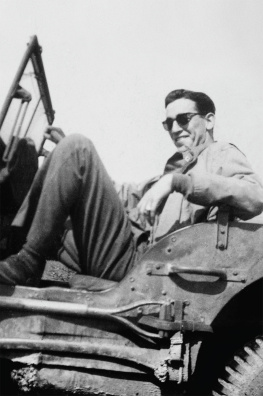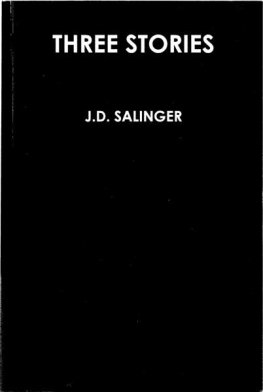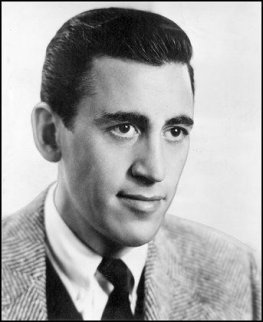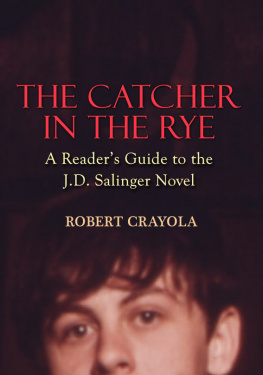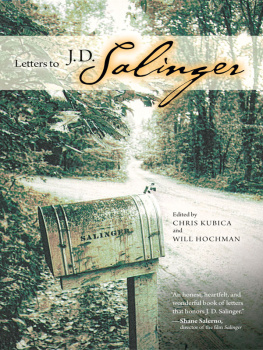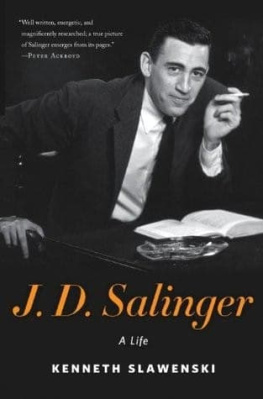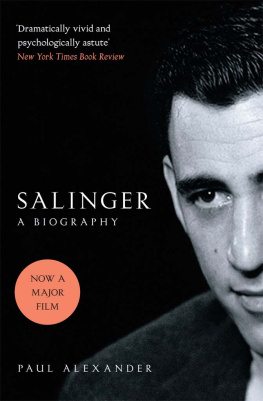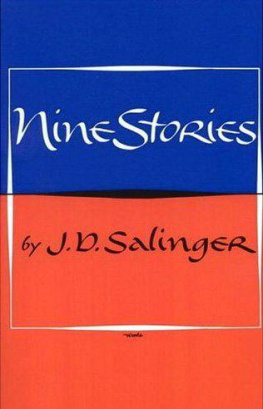Thank you for downloading this Simon & Schuster eBook.
Join our mailing list and get updates on new releases, deals, bonus content and other great books from Simon & Schuster.
C LICK H ERE T O S IGN U P
or visit us online to sign up at
eBookNews.SimonandSchuster.com
CONTENTS
FOR MY MOTHER
Shane Salerno
FOR LAURIE AND NATALIE
David Shields
I was with the Fourth Division during the war. I almost always write about very young people.
J. D. Salinger
What a low and specious thing religion would be if it were to lead me to negate art, love.
J. D. Salinger
INTRODUCTION
J . D. Salinger spent ten years writing The Catcher in the Rye and the rest of his life regretting it.
Before the book was published, he was a World War II veteran with Post-traumatic Stress Disorder; after the war, he was perpetually in search of a spiritual cure for his damaged psyche. In the wake of the enormous success of the novel about the prep school boy, a myth emerged: Salinger, like Holden, was too sensitive to be touched, too good for this world. He would spend the rest of his life trying and failing to reconcile these completely contradictory versions of himself: the myth and the reality.
The Catcher in the Rye has sold more than 65 million copies and continues to sell more than half a million copies a year; a defining book for several generations, it remains a totem of American adolescence. Salingers slim oeuvrefour brief bookshas a cultural weight and penetration nearly unmatched in modern literature. The critical and popular game over the past half-century has been to read the man through his works because the man would not speak. Salingers success in epic self-creation, his obsession with privacy, and his meticulously maintained vaultcontaining a large cache of writing that he refused to publishcombined to form an impermeable legend.
Salinger was an extraordinarily complex, deeply contradictory human being. He was notas weve been tolda recluse for the final fifty-five years of his life; he traveled extensively, had many affairs and lifelong friendships, consumed copious amounts of popular culture, and often embodied many of the things he criticized in his fiction. Far from being a recluse, he was constantly in conversation with the world in order to reinforce its notion of his reclusion. What he wanted was privacy, but the literary silence that reclusion brought became as closely associated with him as The Catcher in the Rye . Much has been made of how difficult it must have been for Salinger to live and work under the umbrella of the myth, which is undeniably true; we show the degree to which he was also invested in perpetuating it.
Other books about Salinger tend to fall into one of three categories: academic exegeses; necessarily highly subjective memoirs; and either overly reverential or overly resentful biographies that, thwarted by lack of access to the principals, settle for perpetuating the agreed-upon narrative. Previous biographies have tended to rely on the relatively small collections of Salinger papers and unpublished manuscripts found at Princeton University and the University of Texas, Austin. The result is the recycling of the same information from a very shallow well and the republication of inaccurate information. The letters we excerpt, ranging from 19402008, are from Salinger to his closest friends, lovers over many decades, World War II brothers-in-arms, spiritual teachers and others; the overwhelming majority of the letters have never been seen before.
We began with three goals: we wanted to know why Salinger stopped publishing; why he disappeared; and what he had been writing the last forty-five years of his life. Over nine years and across five continents, we interviewed more than two hundred people, many of whom had previously refused to go on the record and all of whom spoke to us without preconditions. We aim to provide a multilayered perspective on Salinger, offering first-person accounts from Salingers fellow World War II counterintelligence agents with whom he maintained lifelong bonds, lovers, friends, caretakers, classmates, editors, publishers, New Yorker colleagues, admirers, detractors, and many prominent figures who discuss his influence on their lives, their work, and the broader culture.
By reproducing material that has never been published beforemore than one hundred photographs and excerpts from journals, diaries, letters, memoirs, court transcripts, depositions, and recently declassified military recordswe hope to deliver many factual clarifications and significant revelations. We particularly illuminate the last fifty-five years of his life: a period that, until now, had remained largely dark to biographers.
Still, we faced two major obstacles: The first was that key people had died before we began this project, and the second was that while certain members of the Salinger family initially cooperated, the Salinger family ultimately did not participate in formal interviews. Although they didnt speak directly to us, they had spoken, and through a careful dissection of their public statements and our obtaining of private letters and never-before-published documents, their voices appear throughout this book. In addition, many people unwilling to talk on the record directed us to crucial information and passed on photographs, letters, and diaries they had kept secret their entire lives; half a dozen of our most important interviewees spoke to us only after Salingers death.
We also provide twelve conversations with Salinger: revealing encounters over half a century between journalists, photographers, seekers, fans, family members, and the man who never stopped living his life like a counterintelligence agent. These episodes place the reader on increasingly intimate terms with an author who had been adamantly inaccessible for more than half a century.
There were two emphatic demarcation points in Salingers life: World War II and his immersion in the Vedanta religion. World War II destroyed the man but made him a great artist. Religion provided the comfort he needed as a man but killed his art.
This is the story of a soldier and writer who escaped death during World War II but never wholly embraced survival, a half-Jew from Park Avenue who discovered at wars end what it meant to be Jewish. This is an investigation into the process by which a broken soldier and a wounded soul transformed himself, through his art, into an icon of the twentieth century and then, through his religion, destroyed that art.
Salinger was born with an embarrassing congenital deformity that shadowed his entire life. A college dropout, mercurial talent, wise-guy dandy out of an F. Scott Fitzgerald novel, he was ferociously determined to become a great writer. He dated Oona ONeillthe gorgeous daughter of arguably Americas greatest playwright, Eugene ONeilland published short stories in the Saturday Evening Post and other slicks. After the war, Salinger refused to allow any of these stories to be republished. The war had killed that author.
A staff sergeant in the 12th Infantry, Salinger served through five bloody campaigns of the European Theater of 194445. His job, as a counterintelligence agent, involved interrogating prisoners of war; working the shadow war, the no-mans-land between Allies and Germans; gathering information from civilians, the wounded, traitors, and black marketers. He saw firsthand the wars destruction and devastation. When the end was near, he and other soldiers entered Kaufering IV, an auxiliary of the Dachau concentration camp. Soon after witnessing Kaufering, Salinger checked himself into a Nuremberg civilian hospital, a psychic casualty of the wars final revelation.
Next page
